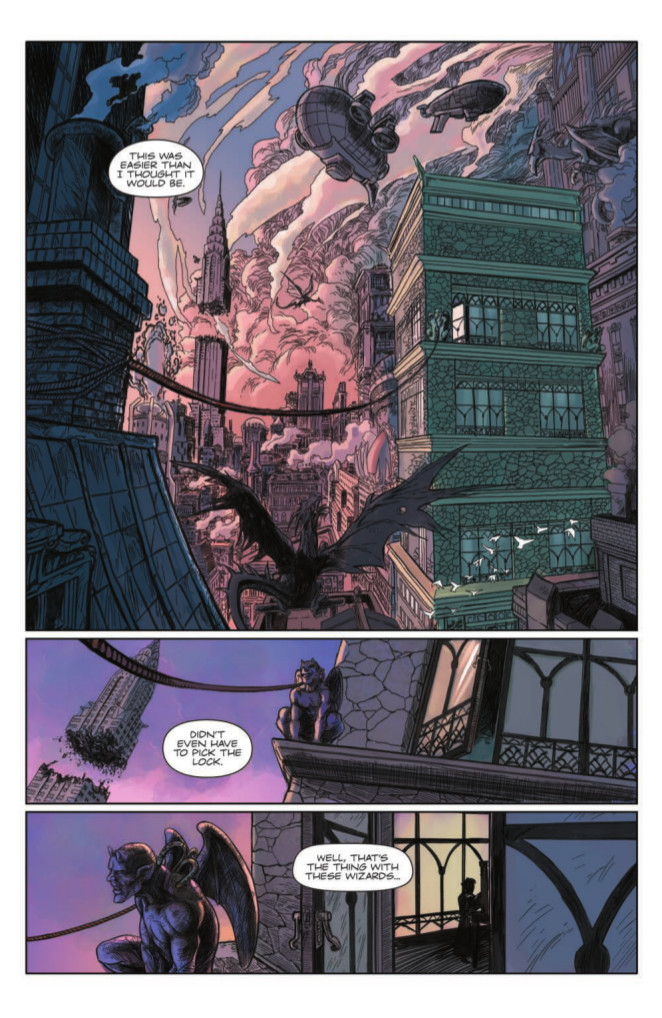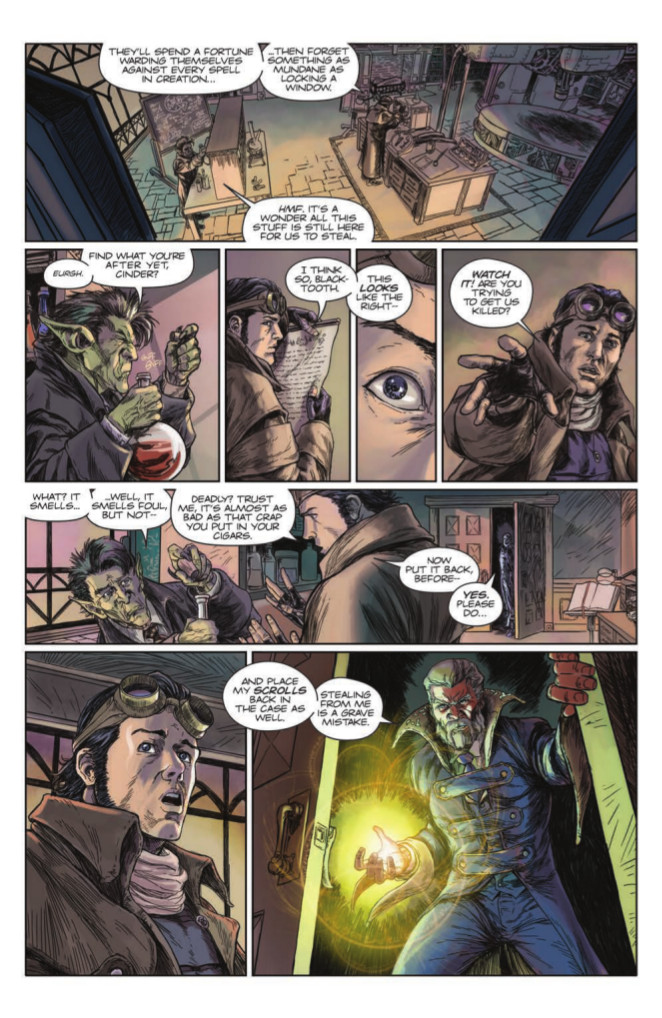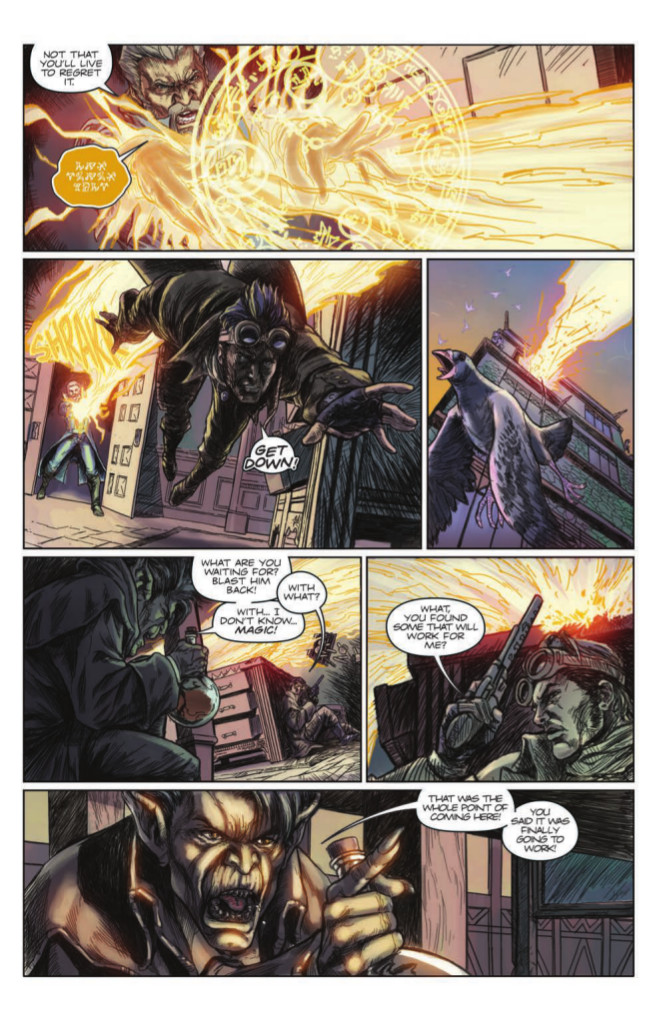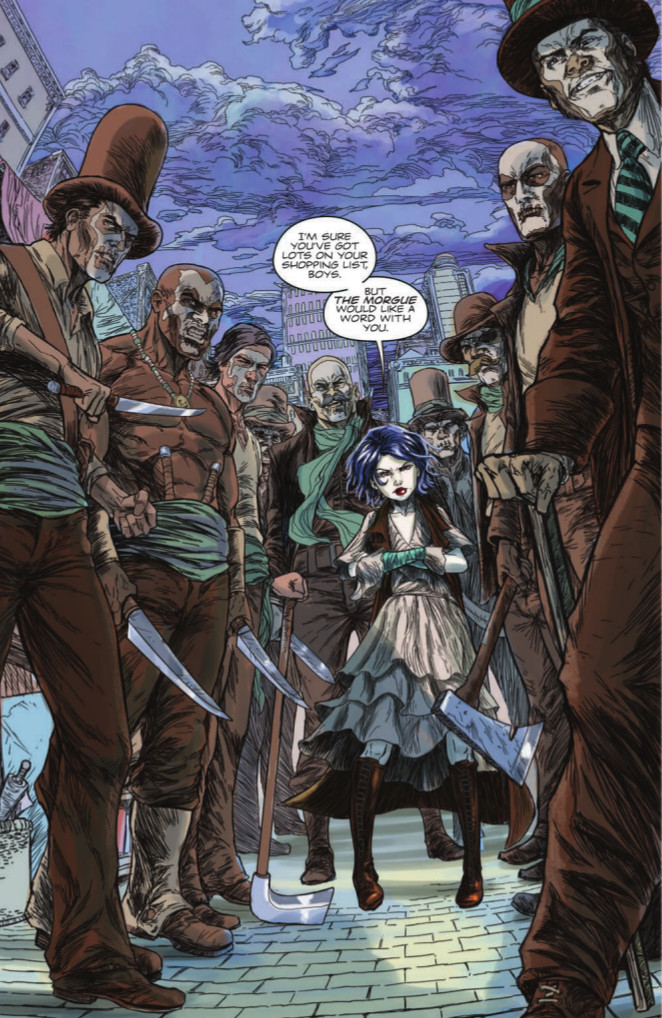The Magic of Art: Brett Barkley Talks His Work and Bringing Gutter Magic to Life
Don’t get me wrong: the magic of comics comes from the marriage of writing and art into a fantastic story. I know this. But art has always been my jam. I often describe artists of all varieties as “wizards” because, to me, that’s pretty much what they are. The ability to take a script or think of an idea and bring that vision to life is a skill I envy and marvel at. And every once in a while, a new (or new to me) artist comes out of nowhere and impresses the hell out of me.
This year’s first for me is Gutter Magic’s Brett Barkley. I’d never seen his art in anything before, but it took exactly one page – well, one panel to be honest – for me to be totally sucked in. It’s easy to understand why if you know me (I have a weird obsession with airships), but the level of detail and vision of that world was so spectacular I was immediately sucked in. Because of that, I had to talk with the guy, so in this week’s art feature, that’s just what we did. Barkley talked with me about his path to comics, how he works, what his inspiration was for Gutter Magic, how the team communicates and puts the book together, and a whole lot more. It’s a great conversation with a newer artist, and one I hope to see a whole lot more from going forward.
If you dig his art, check out his website and follow him on Twitter. Gutter Magic #1 is out now in print and digital formats.
Let’s start with your background. Gutter Magic is the first time I’ve ever experienced your art. What’s your art background – are you self taught, did you go to art school, etc. – and what made you want to work as a comic artist?
BB: I’ve always drawn and been interested in illustration and more specifically, comics and sequential storytelling. Out of high school I had an art scholarship to a small liberal arts college, but at the time their art program didn’t seem to be getting me closer to my goal of getting in to comics work. Understanding that, I changed majors and colleges and earned a Masters degree that enabled me to do the corporate thing and for a time. I worked all over the continental US as a consultant for a Fortune 500 company. But I hated it. I would come back to the hotel every night, work on comic pages until two in the morning building my portfolio. The portfolio I’d carry with me to convention after convention, standing in lines, waiting for reviews. I’ll never forget the hope that would rise up when chosen for the Marvel review raffle, or after kind comments from a respected editor. On Monday, it would be back to a plane ride, an office, and late night drawing in a hotel. I don’t believe I took the quickest, most direct route here.
I’m sure you have a million artists who have inspired and influenced you, but when you’re working and need a bit of inspiration, who or what do you look to in hopes of getting those visual gears turning? And it doesn’t just have to be comic artists. It can be anyone or anything.
BB: Stylistically my art has been very inspired by Joseph Clement Coll. In terms of contemporary comics artists, it’s very difficult to nail down a single handful I like. I don’t believe there is comics art I dislike. I love it all. But I would say I tend gravitate more to Marc Silvestri’s current work, anything Ken Lashley does, Greg Capullo’s work on Haunt, Michael Kaluta, Barry Windsor Smith. I could go on.
For the specific look and feel of the pages I did for Gutter Magic, I wanted to get as close to the penciled look and feel of Leinil Yu’s pages for Ultimate Wolverine vs Hulk I thought the lack of clear black and white reinforced the moral grays of Cinder’s quest. Plus it added a patina to the world that gave it a lived in, used feel.
For Gutter Magic, how did you first get involved with the project, and beyond that, what interested you about that world?
BB: Rich contacted me on the recommendation of our mutual friend, Dafu Yu and asked if I’d be interested in his project, Gutter Magic. To be honest, I had never really had much exposure to the steampunk science fiction sub genre, but while that was definitely intriguing to me, it wasn’t what immediately drew me to the book. What most spoke to me most was the plight of the book’s lead character, Cinder Byrnes. I wanted to be a comic artist since I was very young, helping Spidey out by drawing webbing all over the villains in the comics. But over the years it seemed like achieving that goal was always just out of reach. I believe Rich’s story will genuinely resonate with anyone who has spent any length of time aspiring, working for, dreaming of something elusive.
You’ve already wrapped all four issues of the mini-series, but given that this is one of your first comic projects (maybe your first?), I’m curious: do you feel like that experience was one where you experimented and refined as you went along? Or did you feel that when going in you had a good idea of what you wanted to do?
BB: Actually, I did a couple books in the early 2000s, but see my above comment on how some dreams can be very elusive. I got my first comics work a little over a decade ago through Moonstone Books. I worked on a Bulldog Drummond book with the great William Messner Loebs. But around the time I was getting my first comic project, just when I was thinking I was on the way to achieving the thing I had dreamed about since I was little, my wife and I were hit by a drunk driver. I ended up having two major spine surgeries, years of physical therapy and treatments that never quite got me back to where I had been before the accident. I illustrated much of the Bulldog Drummond book from bed as I literally couldn’t walk for months.
On a number of levels, this project was hugely important for me. I wanted to put my everything in to it. Most of my experimentation and development happened at the beginning. Initially, I had planned on inking the book, but that just didn’t feel right for the story or the world. Back to being inspired by Lenil Francis Yu, I found the color-over-pencils look best suited the story. Once I’d latched on the look and feel I wanted for the art, the world on the pages really started coming to life. Rich has been truly amazing to work with. He trusted me enough to allow me to experiment and develop a world based on his words, though I’m certain he probably got tired of my constant questions on how aspects of the world worked.
Let’s talk tools of the trade. How do you work? Are you a traditional guy, digital or some combination of both? And beyond that, what tools do you use to bring your art to life?
BB: I work entirely digitally. I believe there are no more than two or three Gutter Magic sketches I’ve ever done traditionally. In terms of tools, I use Photoshop on a laptop tablet. I made the switch several years ago after a chance meeting with Scott McCloud at a NYCC. He had mentioned switching to a Wacom-enabled device to counteract arm pain and thought it might work for me and all the pain and nerve issues I was having after my accident. It was some of the best advice for my work I’ve ever received and I’ve been working digitally ever since.

The thing I love the most about Gutter Magic is the world of it. That first panel on the top is the first thing we see in the book, and it’s a hell of an introduction to everything that’s going on. While we haven’t gotten anything with the airships (and may not later), when you and Rich were discussing the buildings and elements like vehicles, was there a particular look you were going for? Or an inspiration?
BB: Rich gave me a lot of freedom to explore the vehicles occupying the world of Gutter Magic. And it was a process to arrive at vehicles that made sense in the world. I did have a number of questions, particularly regarding automobiles. They had existed prior to magic entering this world. Where were they now? Would the airships use styling similar to WWII aircraft? That made sense, as the world’s technical progress would have likely halted at roughly that point. But I think one of the most powerful undercurrents in Gutter Magic is the disparity between the haves and the have-nots, the elite magic users and everyone else. I really tried to consider the extent to which magic would affect everything. I tried to reason that out based on what we see in the real world. After the point magic and magical creatures entered this world, the magic users, the elite, would have little to no reason to live like everyone else. Airplanes and automobiles would have very little use or appeal to them, outside of an extravagant expression of wealth and power. Why would the elites bother with running companies, when they now had license to virtually print their own money and live however they dreamed?
I imagined production of these vehicles would likely halt. To the extent it would serve them, the elites would permit just enough magic to filter its way down to the average person’s day-to-day life in order to maintain the more mundane aspects of running a society. So, while the elite few at the top of this new society could live as they pleased, the average person would have to make do with what he or she could build or cobble together. I tried to reinforce this disparity through the vehicles scattered throughout the story. While the elites will have intricately decorated air yachts, the man on the street will be hauling goods with a horse-drawn carriage enhanced with a steam-powered engine.
You give the look of the world a stunning amount of detail. That isn’t necessarily a common characteristic in comic art. Why was it important to you to give the world of Gutter Magic as much depth as you did?
BB: I grew up in the middle of nowhere. Any comics I could get came from convenience stores, drug stores and the occasional newsstand. I pored over the comics I could get my hands on. I read and re-read them countless times. In my mind, I filled in the space of every gutter with more story, more adventures, more character moments. Those early comics were living stories for me and I still recall them vividly. As I got older and could get to comic shops and conventions, I bought exponentially more comics. But something happened along the way. In order to process all the new books, I read through them quickly, moved on to the next, wash-rinse-repeat. I found I didn’t enjoy them as much. They weren’t as memorable. It wasn’t the fault of the creators. They were fantastic books. It was what I brought to the reading. The reader controls so much of the experience. She can move through the book as quickly as she can read the word balloons, or she can linger on the page, be drawn into a panel, her mind producing a fuller, more affecting experience beyond what’s on the page. I wanted to incentivize the latter by creating a deeper world to dive into.

I really like the second row of panels and how you use it to show the progression of Cinder’s realization of what exactly Blacktooth is doing. When it comes to figuring out the storytelling like that, at what stage do you figure that out? And how much leeway did you have to sort out those things on the page rather than stick straight to scripts?
BB: Rich is amazingly easy to work with. He trusted me enough to add (or in very rare cases, omit) panels as I saw fit for the story. I cannot overemphasize how creatively liberating it was to work with Rich. And it genuinely encouraged me to try to bring more to each panel.
I generally determine a storytelling emphasis and flow in the initial reading of the script. As I read through the panel-by-panel descriptions, I try to get an understanding for the emphasis of the scene. How does it read? Is there an important element that needs to have greater emphasis when compared to the rest? This page (page 2) is a great example of my process. Initially, the script called for five panels: an establishing shot (our first time glimpsing the characters, so it was important), Blacktooth exposition, Cinder reacting to the vial Blacktooth held in his hand (this vial was important, as it would be a plot device in a few pages), Cinder reacting to the wizard entering the room, the wizard preparing to attack them. So it was: intro, exposition, reaction, another reaction, new character exposition.
When I read this page I thought it worked. But Rich allowed me to tell or direct the story as I saw fit and I felt I could enhance the emphasis in a few key places. I gave emphasis to the introduction with a large panel loaded with detail. This shot gives us everything we need to know about the elements in the room that will be important for the rest of the scene. Blacktooth’s exposition I left as it was on the page. I enhanced Cinder’s reaction to the poison they’d be using later in the scene by adding some emphasis panels. This is really bad stuff. I needed another full horizontal panel to break the preceding staccato reaction panels and to introduce the wizard entering the room. This is a new threat. Cinder’s reaction to the wizard in the room is now a new thing—he’s moved on from the poison in the vial. And I left the wizard’s threatening them as it was on the page.
I try to use panel shape and layout always to my advantage. I’ll join ideas in a scene by grouping them with similarly-shaped panels or keeping them on the same panel tier. If I want to separate or break ideas within a scene, I’ll change it up with an abrupt shift in the panel sizing, usually preceded by a horizontal “separation” panel. I generally put a lot of thought in to how I want the story, scene and pacing experienced.

I really love how you demonstrate casting a spell. Was there a particular look you were going for? And I’m curious, how much of this type of thing did you figure out before even getting into drawing the issues themselves?
BB: Once I have an understanding of the story and the world, a lot of the in-panel problem solving occurs while I’m working on the pages. For instance, while I’m working on what I know (roughing in a layout or drawing the characters), I tend to think out what I don’t yet know or understand. As an example, the two-page spread later in the book was the very last thing I drew. I needed a lot of time to reason that out. So it was in the back of my mind while I worked on all the other pages.
Regarding the visual handling of the magic, I arrived at this while working through page two. I knew I wanted an almost technical feel to it. This story takes place in, for all intents and purposes, the modern world. I didn’t want the magic to come across an entirely mystical and unknown. There’s a science, a reason to it. I didn’t want a blast of energy to be simply that. I wanted the visual elements for spellcasting to read very much like a schematic diagram overlaying and changing reality. I even developed a sort of color coding for the type of magic used. I don’t think I’d handle magic the same way for another book, but for Gutter Magic I believe it works.

I have to ask about The Morgue’s crew here. They’re very much like a magic world’s answer to Gangs of New York. When it came to costuming and the looks of characters, what was your inspiration? Was there something in particular you looked to? And beyond that, did you and Rich discuss this type of thing ahead of time, or was that very much on you?
BB: Great eye! I actually did use Gangs of New York for the bulk of my inspiration for the Ghost Knives. Rich had provided me with a beautifully designed concept for Shiver. The design had this really classical elegance to her that I wanted to emphasize through juxtaposition with some rough and street-worn characters. Going with the period feel of her designs, the Gangs of New York costuming was a perfect starting point. I see the Ghost Knives as sort of a cult based around the Morgue character. Emphasis would be placed on death, but filtered through the lens of the period street thug. Throw in some “ghostly green” sashes and some voodoo-style facepaint and there you have it. Oh, and lots and lots of blades.
For the rest of the world, styling for the street level characters generally stuck with slight variations on the period feel. The elves were the exception, however, as Rich had requested they appear significantly more bondage-oriented and body-modified. But I tried to keep everything consistent with the Victorian/Edwardian look.
